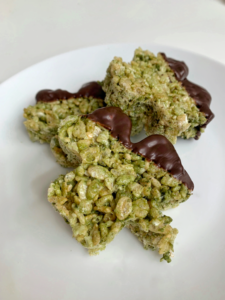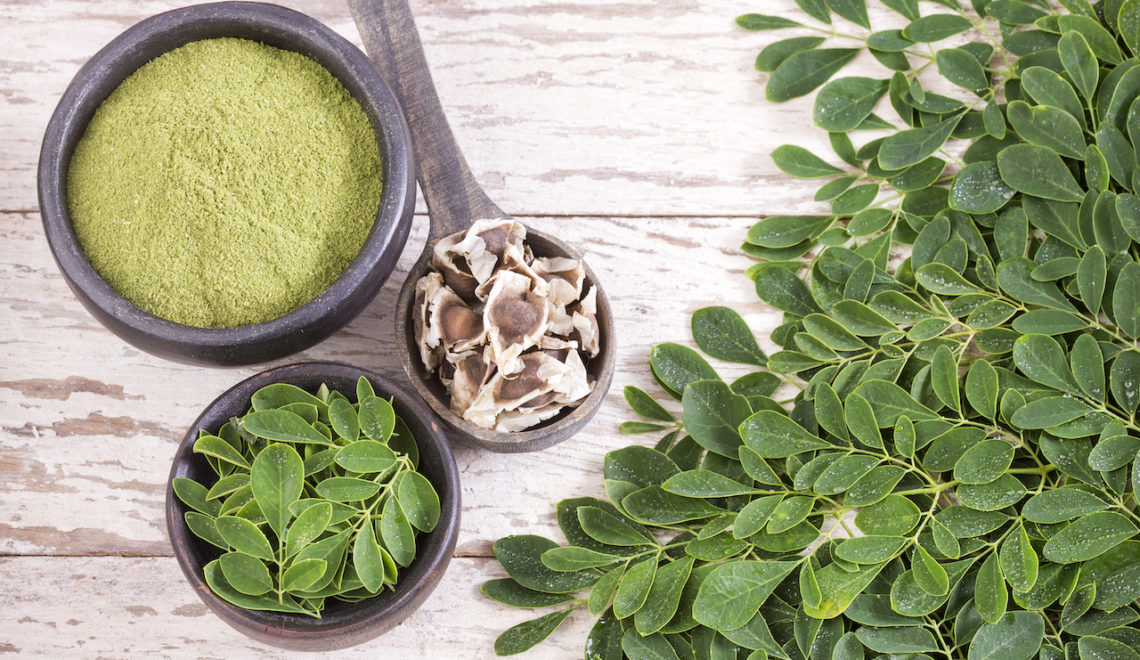Eating moringa everyday might be the new change in your routine, but how do you get kids onboard with this supergreen? We recommend starting slow, with just 1 tsp. of moringa here and there, as part of what we call the “sneaky greens” initiative.
If you’re curious about overall reasons to consume moringa, we summarized it for you in the blog 10 Reasons To Eat Moringa Everyday. For now, we’ll offer the best ways to make moringa a part of your children’s meals. Whether you put it in a morning smoothie or offer it as an afternoon snack, there’s lots of ways to make sure your kids are getting the dense nutrients that this plant offers.
10 Ways to “Moringafy” Recipes for Children
Moringa oleifera is one of the most nutrient-dense green “superfoods” available. It has numerous healing properties [1], which have exponentially increased the demand for this versatile food. Moringa is safe for children and adults, with benefits including treating inflammation, parasitic diseases, joint pain, digestive disorders, hypertension, diabetes, anemia and skin conditions.
That’s not all. Moringa also can provide cardiovascular and immune support, protect against numerous pathogens (E. coli, Salmonella, Candida, H. pylori and Staphylococcus) and enhance lactation for breastfeeding mothers. [2] [4]
Why “Moringafy?”
While moringa’s popularity is gaining momentum here in the U.S., many parents inquire about the best ways to get the slightly bitter moringa into the bellies of their little ones. I’ve coined a new term to identify this enjoyable process: moringafy.

Moringafay (verb): to use moringa to enhance nutritional value of delicious foods, without sacrificing taste
Around the world, moringa has been an essential nutrient in supplemental feeding programs, especially for children. In Uganda, children who are underweight are given locally-sourced soybeans, peanuts and moringa from ages 6–59 months. After 5 weeks with the supplemental feeding program, children gain an average of 2.5g/kg of weight per day. [3]
If you want to learn more about how often to eat moringa and include it in your child’s diet, feel free to explore our article. In general, we recommended eating 1 tsp to 1 tbsp of our pure moringa powder per day. When making single serving portions for children, ½ teaspoon or less of Kuli Kuli’s Pure Moringa is needed. Only use larger amounts, such as whole tablespoons, when moringafying an entire dish for the family.
Moringafy Recipes for Tots
By now, you’re probably ready for our 10 recipes that we have modified “for kids.” Below we have consolidated some of our personal favorites and top recipes that are also tasty to children. If you have additional ideas or questions, feel free to leave us a comment at the end!
1. Moringafy Smoothies
Begin your day with an easy, fun Mommy and Me Smoothie favorite!
2. Moringafy Sauces, Marinaras and Soups
Options are endless when it comes to moringafying savory sauces, delicious curries and scrumptious soups. Let your imagination run wild! These recipes will jump-start your kitchen creativity.
Why not try try a green Thai curry soup, using any milk or alternative milk of your choice? Coconut milk often makes it naturally sweeter, which kids love.
Another classic is a rainbow veggie stir fry with moringa peanut sauce. Kids can also enjoy the “rainbow challenge” of eating every color of the rainbow during one meal.
Lots of veggies make the rainbow challenge possible, from red and orange bell peppers to yellow zucchini and green moringa! If you get stuck with “blue,” you can always offer a sweet bowl of blueberries as dessert.
3. Moringafy Breakfast
Bring nutrition and energy to the start of your family’s day with a granola parfait or green eggs benedict. You may enjoy adding a touch of moringa to a morning omelet as well.
4. Moringafy Pudding
Ready for pudding fun? As the end of the school year approaches, reward a job well-done with thisVegan Chocolate Peanut Butter and Moringa Pudding treat.
5. Moringafy Grilled Cheese and Quesadillas
An oldie, but a goody, the classic grilled cheese. Why not switch it up with this Blueberry Basil and Moringa Grilled Cheese? Your little ones might be delighted with the color, especially if they’re partaking in the rainbow plate challenge! As mentioned above, the rainbow plate challenge is to eat every color of the rainbow during one meal.
Another option is to not add the blueberries, for a more savory and classic grilled cheese. For a double moringa bonus, you could make moringa grilled cheese with moringafyed tomato soup.
6. Moringafy Baked/Fried Foods, Muffins and Breads
It’s easy to add moringa to baked goods without a hitch. The benefits will work their magic while your family may not even notice moringa’s presence. Try this Moringa and Mushroom Arancini for a fun alternative!
7. Moringafy Cheese Spreads, Dips and Guacamole
Need I say more? Delicious guacamole dip or moringa hummus make nutritious spreads for chips, crackers and other snack favorites.
8. Moringafy Desserts
Moringa is undetectable in many desserts, especially chocolate ones.
Two favorites are Moringa Rice Krispies treats and Vegan Brownies for your Valentine or anytime. Yum!
9. Moringafy Pancakes and Waffles
Traditional pancakes and waffles are made more nutritious by adding moringa. Classic moringa pancakes are a great place to start, and we also have a pancake recipe with yogurt too. For those looking to enjoy pancakes as a snack, try the delightful moringa scallion pancakes.
10. Moringafy Casseroles
Adding moringa to your family dishes provides an effective way to boost nutrition and energy for the family without sacrificing taste.
With recipes like these, your little ones will soak up the many nutritious benefits that come from adding moringa to the daily family fare. Many more scrumptious recipes can be found right here on the Kuli Kuli blog. Bon appetite!
We’d love to hear from you and all about your moringafy journey in the comments below!
Follow us @kulikulifoods so we can see some of your favorite ways to add this energizing superfood to your children’s daily routine.
References
- Chodur, G. M., Olson, M. E., Wade, K. L., Stephenson, K. K., Nouman, W., Garima, & Fahey, J. W. (2018). Wild and domesticated moringa oleifera differ in taste, glucosinolate composition, and antioxidant potential, but not myrosinase activity or protein content.Scientific Reports (Nature Publisher Group), 8, 1-10. doi:http://dx.doi.org/10.1038/s41598-018-26059-3
- Fahey, J. W., Olson, M. E., Stephenson, K. K., Wade, K. L., Chodur, G. M., Odee, D., . . . Hubbard, W. C. (2018). The diversity of chemoprotective glucosinolates in moringaceae (moringa spp.).Scientific Reports (Nature Publisher Group), 8, 1-14. doi:http://dx.doi.org/10.1038/s41598-018-26058-4
- Jilcott, S. B., Ickes, S. B., Ammerman, A. S., & Myhre, J. A. (2010). Iterative design, implementation and evaluation of a supplemental feeding program for underweight children ages 6-59 months in western uganda.Maternal and Child Health Journal, 14(2), 299-306. doi:http://dx.doi.org/10.1007/s10995-009-0456-3
- Leone, A., Spada, A., Battezzati, A., Schiraldi, A., Aristil, J., & Bertoli, S. (2015). Cultivation, genetic, ethnopharmacology, phytochemistry and pharmacology of moringa oleifera leaves: An overview.International Journal of Molecular Sciences, 16(6), 12791-12835. doi:http://dx.doi.org/10.3390/ijms160612791
- Uprety, Y., Poudel, R. C., Shrestha, K. K., Rajbhandary, S., Tiwari, N. N., Shrestha, U. B., & Asselin, H. (2012). Diversity of use and local knowledge of wild edible plant resources in nepal.Journal of Ethnobiology and Ethnomedicine, 8, 16. doi:http://dx.doi.org/10.1186/1746-4269-8-16















Are all Kuli Kuli products gluten free.
This is completely a new concept That I have heard of thank you so much for sharing it with us, will surely try making these at home and also share my feedback on how well it cooked and tasted also sharing it with my friends and family as well for their future reference.
Thanks. Excellent post. Many websites refer to have Monriga seeds popcorn. If you have recommendation how to make it, please share.
It sounds like great care is given to process this product without heat. If we bake or pan fry items that have been fortified with the powder, isnt that counter productive for the nutrient values?